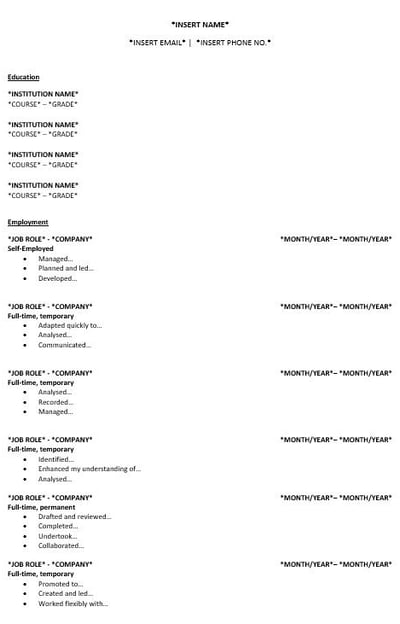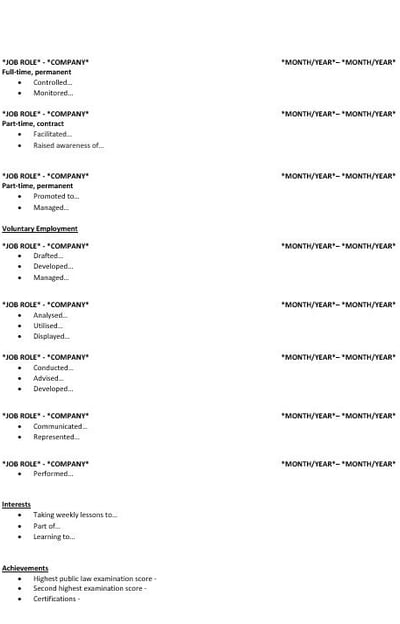Top 5 CV Mistakes You Are Making
Catch Their Attention For All The Right Reasons
CAREERS


Your CV will likely be your potential employer’s first impression of you – so make it count. At LSAB I have reviewed countless CV’s and really have seen the good the bad and the ugly. Below I discuss the top 5 mistakes I consistently come across, and how you can correct them to ensure your CV gets you to that all important next stage. At the end of this post I have included my own redacted CV, showing you a sample format you could use. If you would like a copy of this emailed to you, please reach out using the 'Get In Touch' box at the end of the page.
1. Fancy formatting
Forget it. Throw out the templates, you don’t need them. Recruiters and hiring managers don’t want coloured borders or headers in different fonts - it is distracting and wastes so much space.
What to do instead:
The top line should include your name, the second, your email and phone number. Then get straight into it (see the example CV format at the end of this post). Be consistent with your formatting and your CV will look professional and sleek.
TOP TIP: If you are short for space, use the ‘Line and Paragraph Spacing’ tool on Word. Then select ‘Remove Space After Paragraph’. This will give you more room to showcase your skills and experience.
2. Passive tone
Your CV is about YOU, not about the teams you have worked in. At first, this style of writing can feel uncomfortable, but everyone else is blowing their own trumpet, so you need to as well. It is hard to be convinced by a CV that uses a passive tone.
What to do instead:
Own your experiences and don’t attribute success to other people. Instead of ‘We worked well together as a team to ensure the deadlines were met‘ USE ‘Utilised my interpersonal skills and effectively collaborated across departments with professional communication, to consistently meet strict deadlines.’
TOP TIP: ensure that the first word of each point is a verb - you will be much less likely to slip into that passive tone (see the example CV format at the end of this post for verbs to use).
3. Leaving out the numbers
This point tends to be the least well-received as people think it’s difficult to incorporate. However, it is probably one of the most important, because it will set you apart. Omitting numbers can leave some amazing points feeling deflated.
What to do instead:
For at least one point under each experience, try to quantify things. Instead of ‘Lead on a group project and produced a well-researched and highly graded presentation on-time.’ USE ‘Lead a team of six peers to research, write and deliver a presentation on self-defence in criminal law. This was under the strict time constraint of ten days, and resulted in a grade of 74 – the highest in the cohort’.
NOTICE: in the above, the phrase ‘we’ was omitted, when it could have easily read ‘we received a grade of 74’. Avoid using ‘we’ if possible, own your experiences as discussed in point 2.
TOP TIP: You don’t need to include numbers in every single point, but if it will enhance your description, go for it!
4. Not Tailoring
Not linking your CV to the role you are applying for is a sure-fire way to show the recruiters that you haven’t put time into your application. If your CV has a heading of ‘Legal Experience’ but you are applying for a finance role, this won't look the best.
What to do instead:
Create one CV per sector that can be a general basis for your applications. If you are applying for jobs in both the charity sector and the legal sector, have one for each. The good news is that a lot of skills will be transferrable, but altering a few points to show industry specific skills will go a long way.
TOP TIP: You can also change a couple of points to mirror the job description – it could state that as part of the role you will be expected to ‘take initial instructions from clients’. If you dealt with complaints in your retail job, one point could be ‘Handled initial calls on complaints for customers, logged these and summarised the impact to my line manager.’ This directly mirrors the responsibility you will be expected to take on, making you a more convincing candidate.
5. Repetition
A CV that repeats the same skills wastes space and doesn’t show your full potential. You might have worked well in a team during several of your experiences, but stating this more than once without explaining the difference in dynamics won’t make you sounds any better.
What to do instead:
Think of skills that are unique to the position that you held. If you drafted documents for example, state which ones. Then if drafting was a key part of another role, you can be specific about those documents too, ultimately showcasing two separate skills. For example:
· Drafted and reviewed a wide range of documentation, including, corporate authorisations, security documents and bibles of documents.
· Drafted witness statements for medical negligence claims that were used as evidence in court.
Whilst they both cover the skill of drafting, they are specific to each role.
Next Steps
Now you know how to avoid these top 5 CV mistakes, you are well on the way to drafting a CV that stands out (for all the right reasons).
Below is my own redacted 2 page CV, showing you a sample format you could use. If you would like a copy of this emailed to you, please reach out using the 'Get In Touch' box at the end of the page.






Get in touch
©2023
